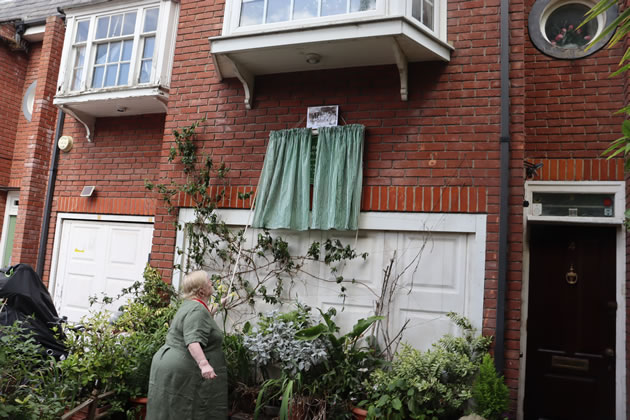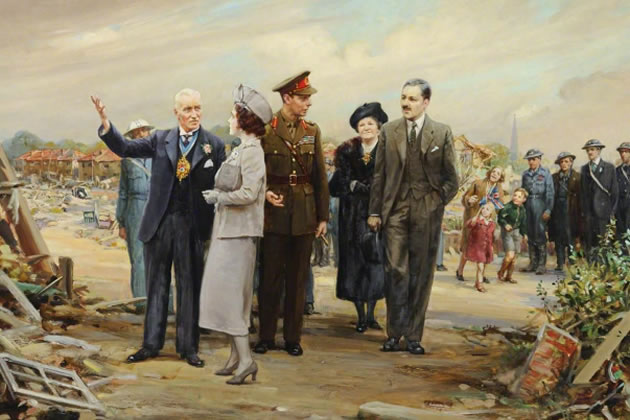Plaque to Wartime Acton Artist Officially Unveiled
Mayor of Ealing does the honours for commemoration of Margaret Dovaston

The plaque was originally put in place during the pandemic
|
May 29, 2025
Around 40 people turned up earlier this month to see the official unveiling of a plaque near the former residence of an Acton artists.
The occasion organised on 18 May jointly by the Acton History Group and the Mill Hill Park Residents' Association witnessed the Mayor of Ealing, Yvonne Johnson, unveiled the plaque, speaking briefly about the artist, and cutting the celebratory cakes, which were edible replicas of Margaret Dovaston's paintings. There was also prosecco on offer, and copies of the history of Mill Hill Park, "Celebrating the Light", obtainable from the Acton History Group.
Nigel Middlemiss, a 40-year-long member of the Acton History Group and a Founder member of the Mill Hill Park Residents’ Association, welcomed the Mayor and the others present.
He said, “The unveiling is one of the purposes of our get-together. The other, at least as important, is to say a very warm thank you to you personally, Madam Mayor. You it was, who as the key voice on the South Acton Ward Forum, backed the idea of this plaque and secured its funding. Some years ago, its unveiling was stopped by the COVID pandemic, but happily can go ahead today.
“And there are other reasons to say a heartfelt ‘thankyou’ to you. You have left your imprint, through the South Acton Ward Forum and other channels, in many many visible ways here – by the designation of Mill Hill Park as a conservation area, to protect what is historic and beautiful; by support for a full-colour history of this area, called “Celebrating the Light”, to remind residents of their heritage, and available here today; and in very many other ways.”

Edible replicas of the artist's paintings wiere served at the event
Mr Middlemass explained that Margaret Dovaston was one of the most accomplished and unusual women artists in Britain in the last century.
He said, “She lived from 1884 to 1954, and her early work was as a war artist / in the First World War. In those days it was an official appointment; artists were sent there to make a record. From the killing fields of Flanders she brought back the most striking and horrifying records of that awful, mechanised conflict, mostly monochrome drawings of pain and death, showing the inhumanity of war.
“Her later and most famous style came as a cheerful contrast to - and relief from - those terrors. It was with so-called genre paintings that she made her name, and fame, and livelihood. Unlike landscape art, or portraits, genre paintings are of domestic scenes, of people living a usually contented and homely life. She painted these in oils at a fantastic rate. As fast as she produced them, her agents sold them, many to Canada, the US and South Africa. They are still popular: a few years ago, her painting “An Afternoon Drink” (typical title) was selling for £33,000 pounds.
“Her favourite subjects / were people from the Regency and Georgian time, pre-1840, often men, wearing brightly coloured frock coats, in stylish baroque interiors with mullioned windows and ornamental fireplaces. There they are occupied with (mercifully) sociable things far from fighting wars: planning a journey, playing chess, telling anecdotes, and drinking toasts.
“At the same time Margaret had a twinkle in her eye about the way men, for her, make plans, relate anecdotes, look at maps, talk about journeys: they are actions done for their own leisurely sake rather than for any truly serious purpose. “
Although the house she lived in with its artist’s studio is no longer there, it is exactly 100 years since she moved into 51 Avenue Gardens which was designed by her architect brother John. She was already well embedded in Ealing life, after attending the Ealing School of Art, and setting up the Ealing Art Guild later the Ealing Arts Club.
She also lived through World War Two here, acting as the local Air Raid Warden, with an air-raid shelter in her garden.
The painting below shows the Mayor of Ealing meeting Mr Willoughby with the King and Queen to see the aftermath of a Luftwaffe raid on the borough.
 “George VI and Queen Elizabeth Inspecting Air Raid Damage at Perivale, 27th September 1940” by Margaret Dovaston. Picture: Ealing Central Library
“George VI and Queen Elizabeth Inspecting Air Raid Damage at Perivale, 27th September 1940” by Margaret Dovaston. Picture: Ealing Central Library
Value Reading Articles Like This? Help Us Produce More This site remains committed to providing local community news and public interest journalism. Articles such as the one above are integral to what we do. We aim to feature as much as possible on local societies, charities based in the area, fundraising efforts by residents, community-based initiatives and even helping people find missing pets. We've always done that and won't be changing, in fact we'd like to do more. However, the readership that these stories generates is often below that needed to cover the cost of producing them. Our financial resources are limited and the local media environment is intensely competitive so there is a constraint on what we can do. We are therefore asking our readers to consider offering financial support to these efforts. Any money given will help support community and public interest news and the expansion of our coverage in this area. A suggested monthly payment is £8 but we would be grateful for any amount for instance if you think this site offers the equivalent value of a subscription to a daily printed newspaper you may wish to consider £20 per month. If neither of these amounts is suitable for you then contact info@neighbournet.com and we can set up an alternative. All payments are made through a secure web site. One-off donations are also appreciated. Choose The Amount You Wish To Contribute. If you do support us in this way we'd be interested to hear what kind of articles you would like to see more of on the site – send your suggestions to the editor. For businesses we offer the chance to be a corporate sponsor of community content on the site. For £30 plus VAT per month you will be the designated sponsor of at least one article a month with your logo appearing if supplied. If there is a specific community group or initiative you'd like to support we can make sure your sponsorship is featured on related content for a one off payment of £50 plus VAT. All payments are made through a secure web site. |